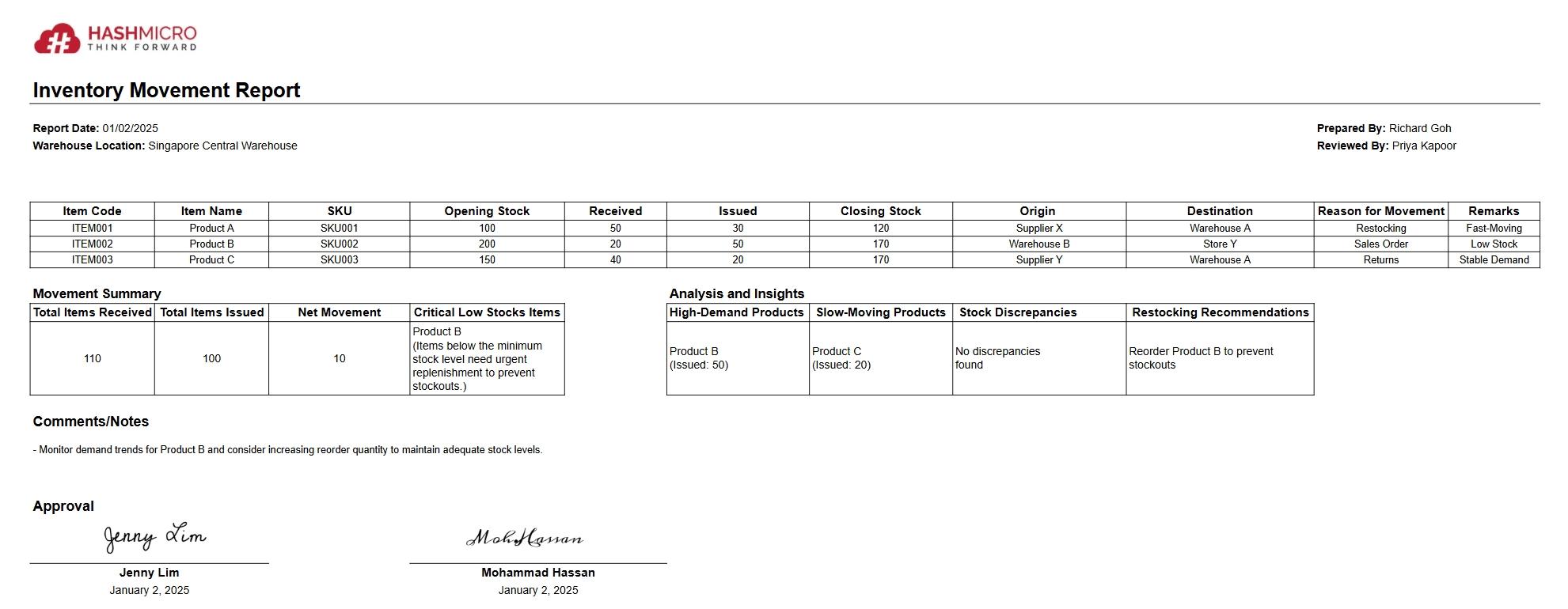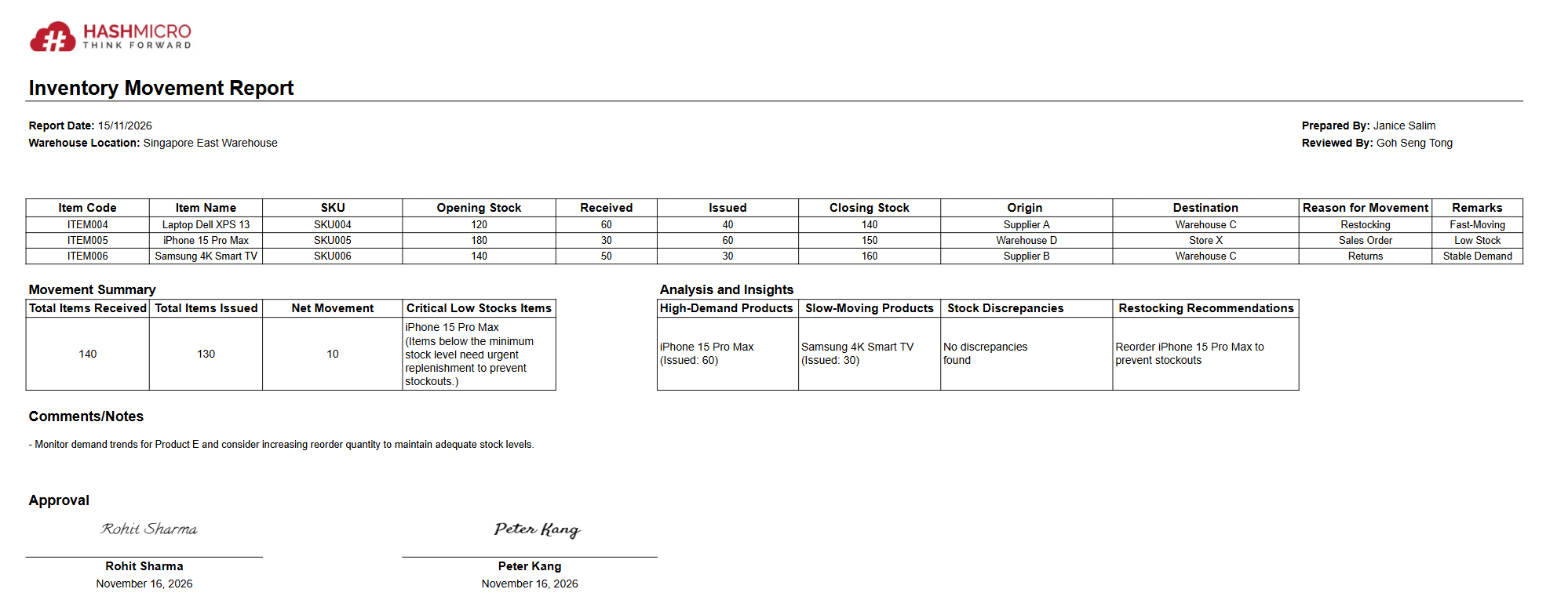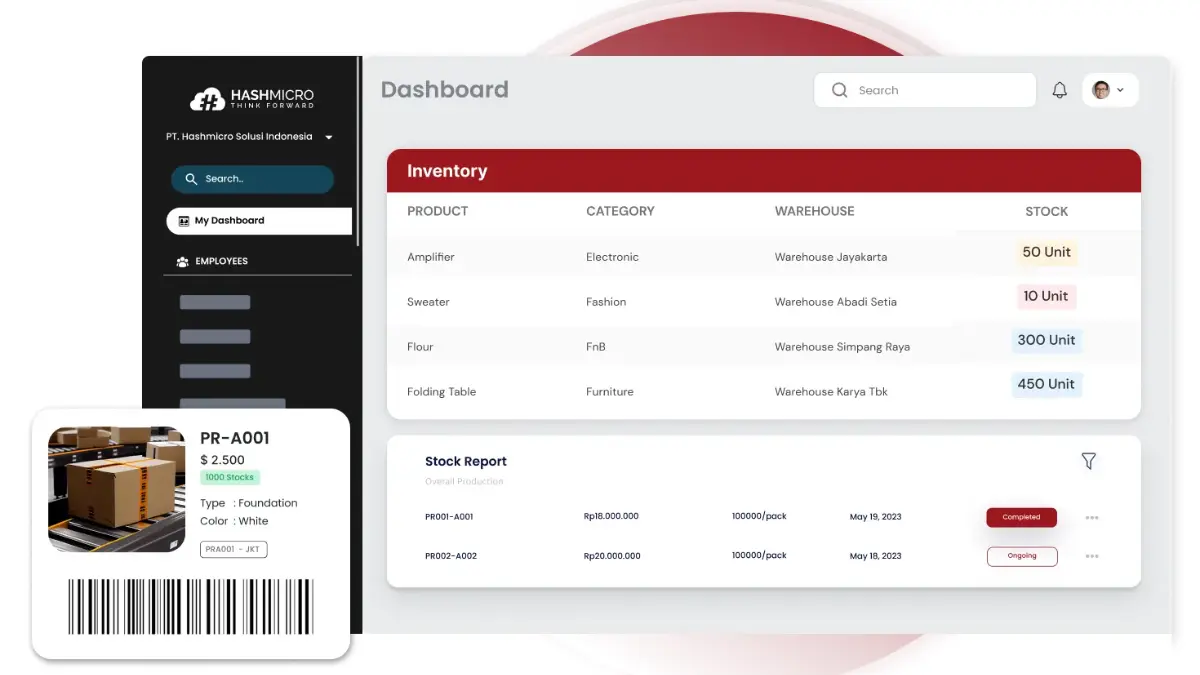Inventory movement report is the backbone of efficient stock management, helping businesses track every item that moves in or out of the warehouse. From incoming shipments to outgoing orders, I’ve seen how a well-structured report ensures transparency and control over daily operations.
In Singapore, the WMS market is projected to grow at a 15% CAGR from 2024 to 2030, fueled by the demand for smarter inventory management in logistics and e-commerce. This trend highlights how vital accurate inventory tracking is for maintaining agility and meeting customer needs.
With the right inventory software, you can automate data collection, gain real-time visibility, and make informed decisions that boost efficiency. Ready to optimize your warehouse operations? Get a free demo today.
Key Takeaways
|
What is an Inventory Movement Report?
An inventory movement report is a detailed document that tracks inventory flow within a business, including stock arrivals, transfers, and shipments. It shows how products are moved in and out of storage, helping businesses maintain accurate stock levels and track inventory turnover.
An inventory movement report includes critical components such as stock entries and exits, quantity and value tracking, dates and time stamps, location information, and item descriptions. It records all instances of inventory coming into the warehouse, such as new purchases and returns.
Where Can a Stock Movement Come From?
Stock movement refers to the changes in inventory levels due to various business activities. Here are some key sources of stock movement:
- Purchasing activities: Stock levels increase when a business orders and receives products from suppliers.
- Sales transactions: Sales activities reduce available stock as items are sold and removed from inventory.
- Returns and exchanges: Customer returns add items to inventory, while exchanges may adjust stock levels based on the new item taken.
- Stock transfers: Transferring stock between multiple locations or warehouses affects inventory levels at different sites.
- Adjustments and write-offs: Discrepancies, damage, or obsolescence may require adjustments or writing off unsellable items.
- Inventory shrinkage: Shrinkage from theft, loss, or damage to inventory can lead to a stock movement that must be monitored.
Understanding these sources of stock movement helps businesses implement effective inventory management practices and optimize stock levels.
What is Inventory Movement Report Used For?
An inventory movement report is a vital tool for tracking stock movement within a business, capturing essential insights into inventory changes over time. Here are the primary uses of an inventory movement report:
1. Demand forecasting
By analyzing historical stock movements, businesses can identify patterns in product demand, helping them make informed decisions about restocking and purchasing. This report aids in predicting future needs, ensuring that popular items are consistently available without overstocking slower-moving products.
2. Cost control
Inventory carrying costs can be substantial, especially with excess or obsolete stock. An inventory movement report allows businesses to monitor stock levels and reduce unnecessary storage expenses.
3. Identifying inefficiencies and improving operations
This report shows where inventory bottlenecks or delays occur, whether in restocking, fulfillment, or supply chain processes. Businesses can optimize lead times, improve operational workflows, and enhance efficiency by identifying these gaps.
4. Enhancing customer satisfaction
Accurate stock availability is crucial for meeting customer demand and fulfilling orders on time. Inventory movement reports help prevent stockouts and delays, enabling businesses to offer a better customer experience and boost customer loyalty.
An inventory movement report is essential for demand forecasting, cost control, operational improvement, and customer satisfaction. It equips businesses with data-driven insights to maintain optimal stock levels and improve the effectiveness of their inventory management practices.
Inventory Movement Challenges
Businesses often face challenges that can disrupt this flow and lead to costly inefficiencies. Recognizing these obstacles can help businesses develop strategies to address and overcome them, improving inventory accuracy and operational efficiency.
1. Inaccurate data entry
One of the most common challenges in inventory management is inaccurate data entry. Manual data entry errors can occur when recording inventory movement, leading to discrepancies between actual stock levels and recorded amounts.
2. Demand variability
Fluctuating demand can complicate inventory movement, especially in industries with seasonal trends or unpredictable customer behavior. When demand is inconsistent, businesses may struggle to maintain optimal stock levels, experiencing stockouts during high-demand periods or excess inventory when demand drops.
3. Stock shrinkage
Stock shrinkage refers to losses due to theft, damage, or administrative errors. These incidents can lead to unaccounted inventory movement, impacting stock accuracy and causing financial loss. Implementing security measures, conducting regular stock audits, and training staff in proper handling and tracking practices can mitigate stock shrinkage.
4. Lack of real-time visibility
Without real-time visibility into inventory movement, businesses struggle to track stock levels accurately and respond quickly to demand changes. Delayed updates can lead to decisions based on outdated information, affecting inventory management.
Implementing cloud-based inventory systems can address this issue by providing up-to-date information on stock levels, enabling businesses to respond quickly to demand changes and avoid costly inefficiencies.
5. Complexity in multi-location management
For businesses operating across multiple warehouses or retail locations, tracking inventory movement becomes more complex. Coordinating stock transfers and monitoring inventory levels at each site can lead to inefficiencies and imbalances.
A centralized inventory management system that tracks movement across locations can help streamline this process and provide a unified view of stock levels.
Challenges like inaccurate data entry, demand variability, stock shrinkage, inefficient restocking, lack of real-time visibility, and multi-location management complexities can hinder inventory movement. Addressing these obstacles with the right tools and strategies is essential for maintaining efficient, accurate, and responsive inventory management.
How to Write an Inventory Movement Report?
Creating an influential inventory report requires a structured approach to capture every detail of stock movement. Here’s a step-by-step guide on how to write a comprehensive inventory or item movement report:
1. Define the scope of the report
Start by clarifying the report’s purpose and timeframe. Determine if the report will cover daily, weekly, or monthly inventory reports and specify which products or locations it will include. Defining the scope helps focus the report and accurately captures all necessary details.
2. Identify key data points
To provide a complete picture of inventory movement, identify the data points that need to be tracked, such as product name, SKU, date of movement, quantity, origin, destination, and the reason for the movement (e.g., sales, restocking, returns).
3. Record incoming inventory
Begin by documenting all incoming stock, including new supplier shipments, customer returns, or transfers from other locations. For each entry, specify details like the supplier name, receiving date, product quantity, and any additional costs associated with the shipment.
4. Track outgoing inventory
Next, document all outgoing stock, including sales orders, suppliers’ returns, or inventory transfers. Include the destination, quantities, dates, and reasons for each outgoing movement. This information helps track how inventory is distributed and highlights trends in product demand.
5. Calculate stock levels and adjustments
Calculate the current stock levels by adjusting quantities based on incoming and outgoing movements. This calculation ensures accurate inventory records and helps detect discrepancies that might require adjustments.
6. Analyze and summarize data
Once all movements are recorded, analyze the data to identify trends or anomalies. Summarize the findings to provide insights into demand patterns, high-turnover items, or inefficiencies in restocking. Adding a summary or insights section in the report makes it easier for stakeholders to understand critical takeaways and informs future decision-making.
In conclusion, writing an inventory movement report involves defining the scope, tracking key data points, recording incoming and outgoing stock, and analyzing trends. By following these steps, businesses can create an organized, insightful report that supports effective inventory management and data-driven decisions.
Inventory Movement Report Parameters
Creating an influential Inventory Movement Report requires tracking specific parameters to capture inventory flow details accurately. These parameters form the foundation of the report, ensuring that each movement of stock is documented and analyzed for better decision-making. Here are the essential parameters to include:
1. Product information
Product details such as the item name, SKU (Stock Keeping Unit), and category are essential to identifying each product in the report. Including this information ensures no confusion about which item is being tracked, especially in businesses with a diverse inventory.
2. Movement date
The date of each stock movement is crucial for tracking when inventory changes occur. This parameter allows businesses to monitor stock flow over time, identify high-demand periods, and adjust based on seasonal or recurring demand patterns.
3. Source and destination locations
For businesses with multiple storage sites, specifying the origin and destination of each inventory movement is essential. This parameter helps track where stock is moved from and to, enabling businesses to maintain balanced stock levels across locations and prevent overstocking or stockouts.
4. Quantity moved
Recording the number of items moved in each transaction provides a clear view of how much stock is added or removed. This parameter helps maintain accurate stock counts and ensures the reported levels align with the inventory.
5. Movement type
Different stock movements, such as purchases, sales, returns, transfers, and adjustments, impact inventory differently. Labelling each movement by type allows businesses to categorize transactions, making it easier to analyze which activities drive stock changes and identify potential issues.
6. Cost and price data
Including each item’s cost per unit and selling price (if applicable) helps evaluate the financial impact of stock movements. Cost and price data provide insights into inventory valuation, profitability, and the cost-effectiveness of each product in stock.
7. Reason for movement
Specifying the reason behind each inventory movement, such as a customer return, damaged goods, or promotional sale, adds context to the report. This parameter helps understand the root causes of changes in stock levels and identify patterns in customer behaviour or product issues.
8. Current stock levels
Updating the current stock level after each movement is recorded ensures that inventory records remain accurate and up-to-date. This parameter allows real-time visibility into stock levels, crucial for maintaining adequate inventory and preventing discrepancies.
Including these parameters in an inventory movement report provides a complete picture of how stock flows through the business. By tracking product information, dates, quantities, costs, and movement types, companies can maintain precise records, make informed inventory decisions, and enhance overall inventory management efficiency.
Inventory Movement Report Template
An inventory movement report is crucial for providing a clear record of every addition and removal within the inventory. It enables businesses to respond quickly to demand changes, address supply issues, and minimize holding costs.
This template streamlines inventory tracking by capturing stock movements, from opening balances to received and issued quantities, ensuring businesses maintain optimal inventory levels. It helps prevent shortages, supports data-driven restocking decisions, and enhances overall efficiency.
With clearly structured sections for movement summaries, key insights, and approvals, it provides a seamless way to manage inventory while improving accuracy and operational control.
Inventory movement report template 1


Inventory movement report template 2


Automate Inventory Movement Reporting with HashMicro

Automating inventory movement reporting can significantly improve efficiency, accuracy, and real-time visibility in managing stock levels. HashMicro’s Inventory Management Software is designed to streamline tracking and reporting inventory movements.
This system captures every incoming and outgoing stock transaction, from purchase orders and sales to returns and adjustments, ensuring that all movements are automatically logged and readily accessible.
Some other advantages of the HashMicro inventory system include:
- OCR for Receiving: OCR technology quickly scans and digitizes incoming stock documents, reducing manual entry errors and speeding up the receiving process.
- Stock Forecasting: Predicts future inventory needs based on sales trends and historical data, helping businesses maintain optimal stock levels and avoid shortages or excess.
- Run Rate Reordering Rules: Automates reordering by setting reorder points based on item usage rates, ensuring essential items are restocked in time.
- Fast-moving, Slow-Moving, and non-moving Stocks Analysis categorizes inventory by demand, helping businesses identify high-demand products, manage slow-movers, and reduce costs on non-moving stock.
- Racking Capacity with Putaway Strategy: Manages storage space and assigns optimal locations for each item to maximize warehouse efficiency and streamline order fulfillment.
With these features, HashMicro’s Inventory Management System enhances control over inventory processes by automating essential tasks and providing real-time insights.
“An inventory movement report isn’t just a record; it’s a vital insight tool. It helps managers track trends, prevent stock issues, and make smarter, faster inventory decisions.”
— Angela Tan, Regional Manager
Conclusions
The inventory movement report is a crucial tool for businesses seeking to optimize their inventory management. Understanding the patterns in inventory movement helps businesses minimize excess stock, reduce carrying costs, and enhance customer satisfaction.
HashMicro offers a comprehensive solution for inventory management that streamlines tracking inventory movements. With its user-friendly interface and powerful analytics, HashMicro allows businesses to generate accurate inventory movement reports effortlessly.
We invite you to sign up for a free demo today to see the benefits of HashMicro’s inventory management solutions firsthand and experience how our tools can transform your inventory management practices and drive your business towards more tremendous success.
Warning: Undefined array key "med" in /home/hashmicr/public_html/blog/wp-content/plugins/insert-headers-and-footers/includes/class-wpcode-snippet-execute.php(419) : eval()'d code on line 281

FAQ About Inventory Movement Report
-
How do you track inventory movement?
Inventory movement can be tracked using manual logs, spreadsheets, or specialized inventory management systems. Automated systems often utilize barcode scanning or RFID technology to capture stock movements in real-time, updating inventory levels as products are received, sold, or transferred.
-
How do you analyze inventory movement?
Analyzing inventory movement involves reviewing data from inventory reports, such as the Inventory Movement Report, to identify trends in stock levels. Businesses assess metrics like inventory turnover rates and frequency of stockouts or excess inventory to make informed decisions about purchasing and optimization.
-
How do you write an inventory report?
To write an inventory report, define its purpose and scope and gather data on stock levels and movements. Organize the information into clear sections, including an overview of inventory status and an analysis of trends. Finally, provide recommendations based on the findings to guide future inventory management strategies.
-
What can the stock movement report show you?
A stock movement report provides insights into stock quantities purchased, sold, returned, and transferred during a specific period. It reveals trends in inventory levels, identifies slow-moving or fast-selling items, and highlights discrepancies, helping businesses optimize inventory practices.














